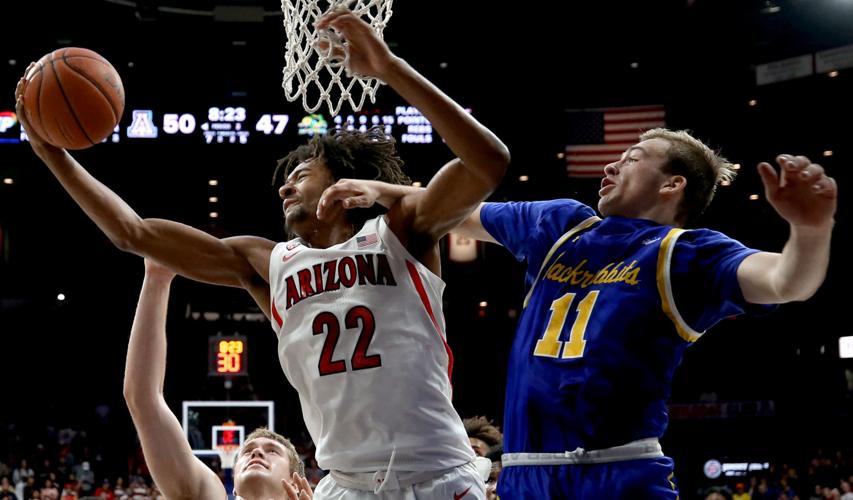Even after he missed his first field goal in 18 tries Thursday, errantly lofting a difficult putback attempt high above the McKale Center rim, Arizona forward Zeke Nnaji still led all of Division I in field-goal percentage at 84.1.
The way UA coach Sean Miller described it after Arizona hung on to beat South Dakota State 71-64, that fact should be plastered all over the Wildcats’ locker room.
Or, better yet, ingrained deep in their heads.
Because Nnaji did not take a single shot in the first half.
“If you lead the nation in anything, you are outstanding,” Miller said. “You have the nation’s leading field-goal shooter on your team and he doesn’t take one jump-hook? Not one? That’s a problem.”
It was actually the second straight half that Nnaji didn’t take a shot, with the ball taken out of his hands in the second half on Nov. 17 against New Mexico State after he hit 7 of 7 before halftime.
But that game was an 83-53 blowout win for the Wildcats. What Nnaji did ultimately wasn’t that critical.
And maybe it won’t be Sunday, when UA hosts Long Beach State. But on Thursday, it was.
The Wildcats were facing a plucky low-major power, still adjusting from the loss of its coach (T.J. Otzelberger, to UNLV) and star (Mike Daum, to Spain) but carrying the confidence of a team that has been to five of the last eight NCAA Tournaments.
“They’re used to winning,” Miller said.
For a long while, they were on track to do just that. The Jackrabbits of Brookings, South Dakota, led the game for over 20 minutes, taking leads of up to 10 points. They helped force 12 Arizona turnovers before halftime. They shot 48% in the first half against UA’s Top 20 defense.
And their packed-in defense, somewhat like Arizona’s typically does, made life rough on drivers and Nnaji alike while daring the Wildcats to jack up 3-pointers — which was precisely what Arizona did.
UA made just 3 of 14 3s in the first half, tossing what Miller referred to as “circus shots” at times, and Miller couldn’t help but wonder if some of those shots should have been passes inside to Nnaji instead.
The Jackrabbits were making life tough on Nnaji, however. They harassed and double-teamed him on the few occasions he did get the ball, with Nnaji picking up two fouls and two turnovers in the first half.
Even when UA did pass more often to him in the second half, center Chase Jeter noted, the Jackrabbits “were sending that double-team over fairly quickly.”
But the stats suggested Miller had a point, that trying to get the ball to Nnaji whenever viable was still the best way to go.
While missing 11 shots from 3-point range in the first half, the Wildcats made 8 of 10 shots inside – Nnaji-like precision without Nnaji taking a single one of them.
That’s 16 points on 10 shots taken inside. Nine points on 14 shots taken outside.
The difference in efficiency was obvious. At least to those who weren’t on the floor.
“Percentages don’t lie,” Miller said. “We have to take uncontested, wide-open 3s, and we have a couple guys on our team that are elite 3-point shooters. Nico (Mannion) is one of them. Sometimes a quick 3 by him, an off the dribble 3 by him, is completely understood because he can really shoot the ball.
“But we had kind of an audition going on by our perimeter players to see who has the most 3s taken. And it’s just not the smart way for us to play the game.”
Miller went on.
He said SDSU was facing a UA team that “wasn’t very smart,” taking ill-advised shots against a solid defensive team as if at “carnival.”
“It’s just like, ‘My turn. You shoot a 3? Well, let me shoot a 3.’ We took 13 3s in 20 minutes, so those 3s better be going in,” Miller said.
They weren’t. UA cut down on them drastically in the second half, for which Miller gave them credit, but missed all three 3s it took after halftime.
Nnaji, meanwhile, showed again why it pays to get him the ball.
He hit all four field goals he took after his lone miss, then took six trips to the free-throw line and hit four of those free throws.
It wasn’t as perfect as Nnaji had been, also having made 14 straight free throws before missing his second attempt Thursday, but he was clearly more efficient than his teammates were from the perimeter.
Meanwhile, Miller blamed the offensive inefficiency for other troubles. UA allowed the Jackrabbits to shoot 46.8% overall from the field, barely outrebounded them 32-30 and gave up a total 15 turnovers (though the Wildcats did take advantage of 21 SDSU turnovers by scoring 22 points off them).
“That bad offense bleeds into defense, and next thing you know you just don’t really play well,” Miller said.
After Thursday’s game, Miller pledged that those who were less efficient would have to “shoot less, or play less” and vowed that the issue would “be corrected first thing tomorrow.”
The Wildcats had Friday and Saturday to work on the issue before Sunday’s game, their last home game before they begin Wooden Legacy play on Thursday by facing Pepperdine.
“We have to take advantage of the gifts that we have,” Miller said. “Zeke doesn’t take bad shots. He doesn’t. And when we can get him the ball, good things happen.
“That doesn’t mean he’s going to shoot it every time or that all these other players we have aren’t allowed to shoot it.
“But you can’t let 20 minutes go by where he doesn’t get one good shot.
“It clearly is a lesson that we needed to learn. I’m glad we were able to win. I really am, because we played with fire.”





